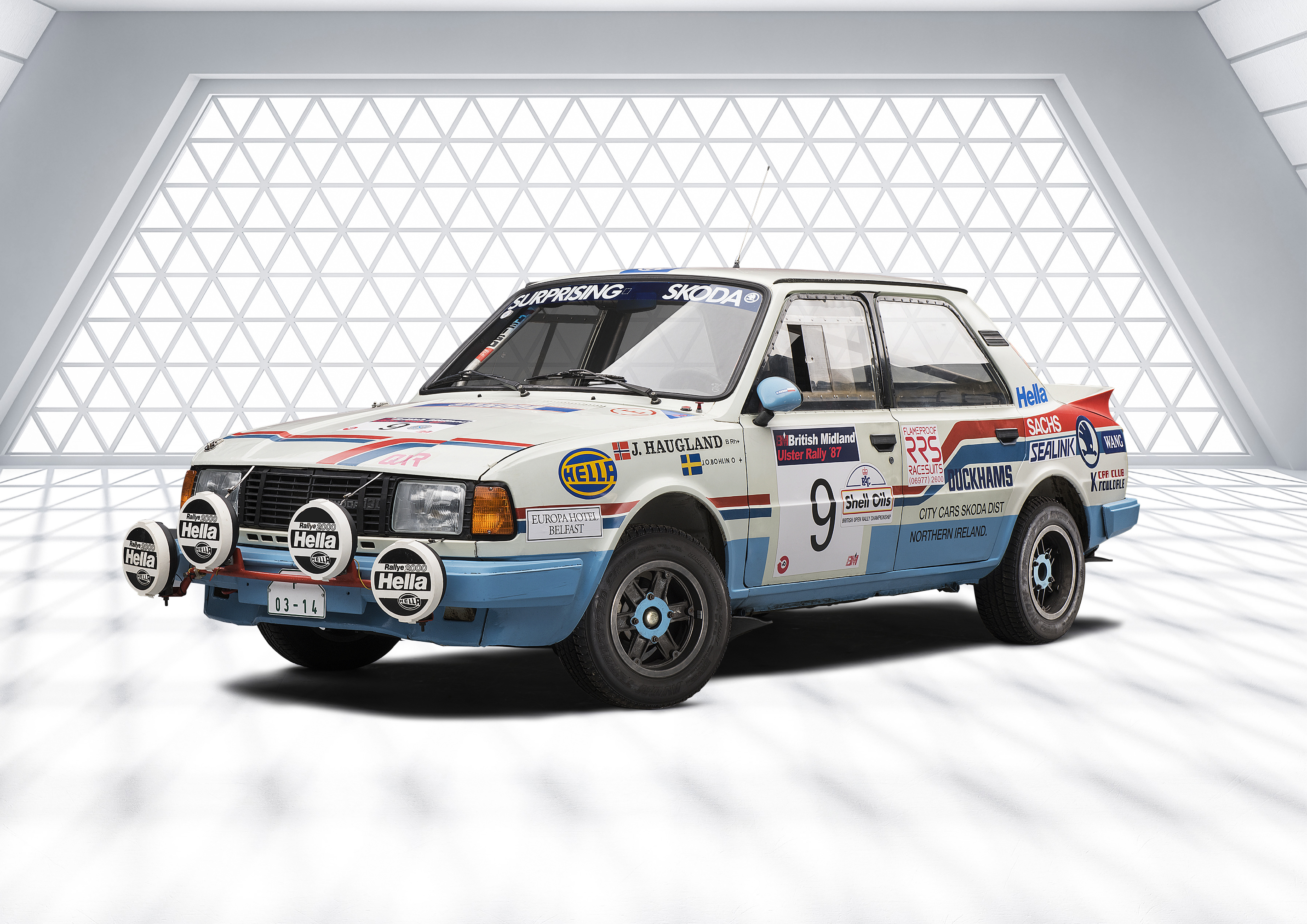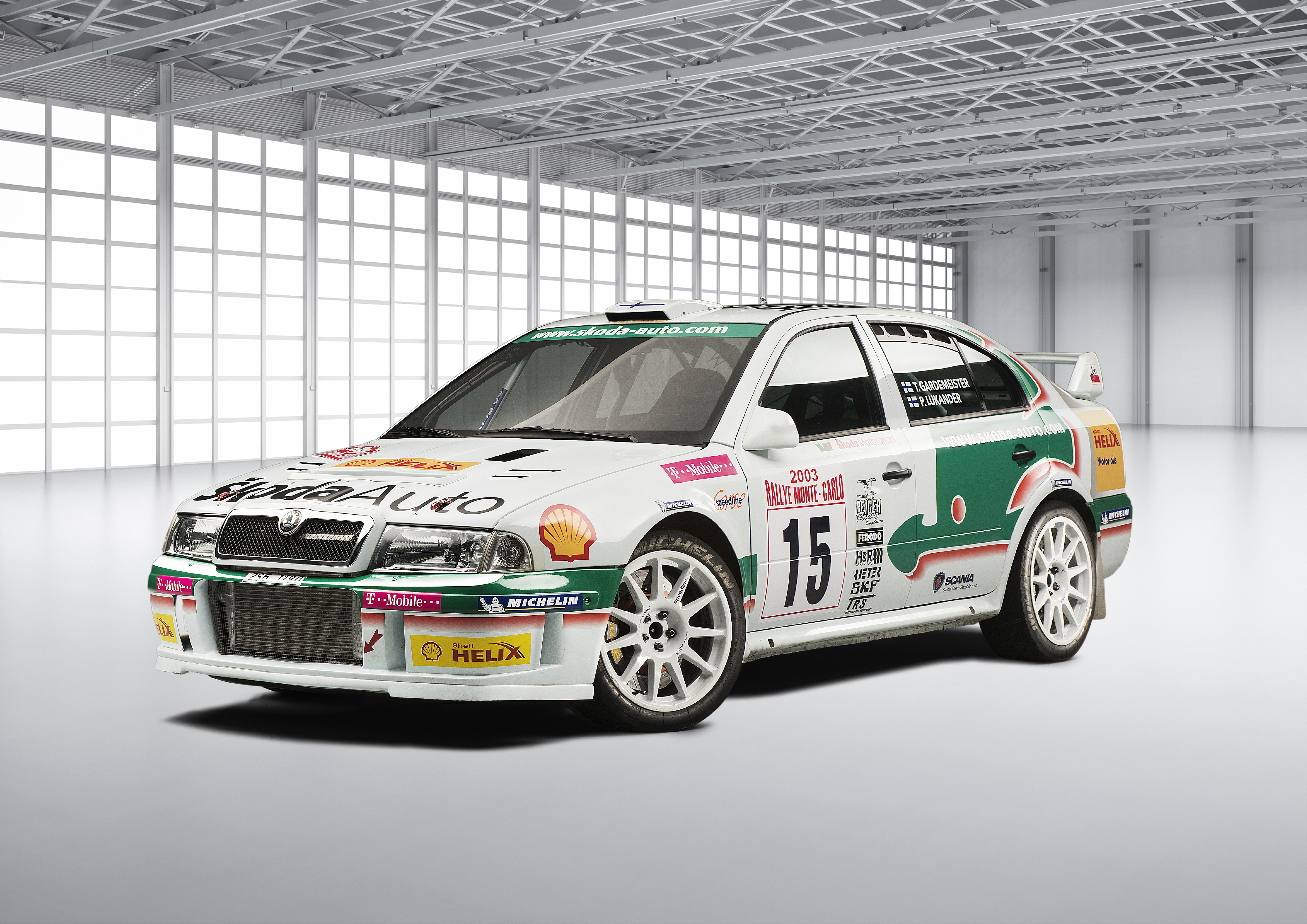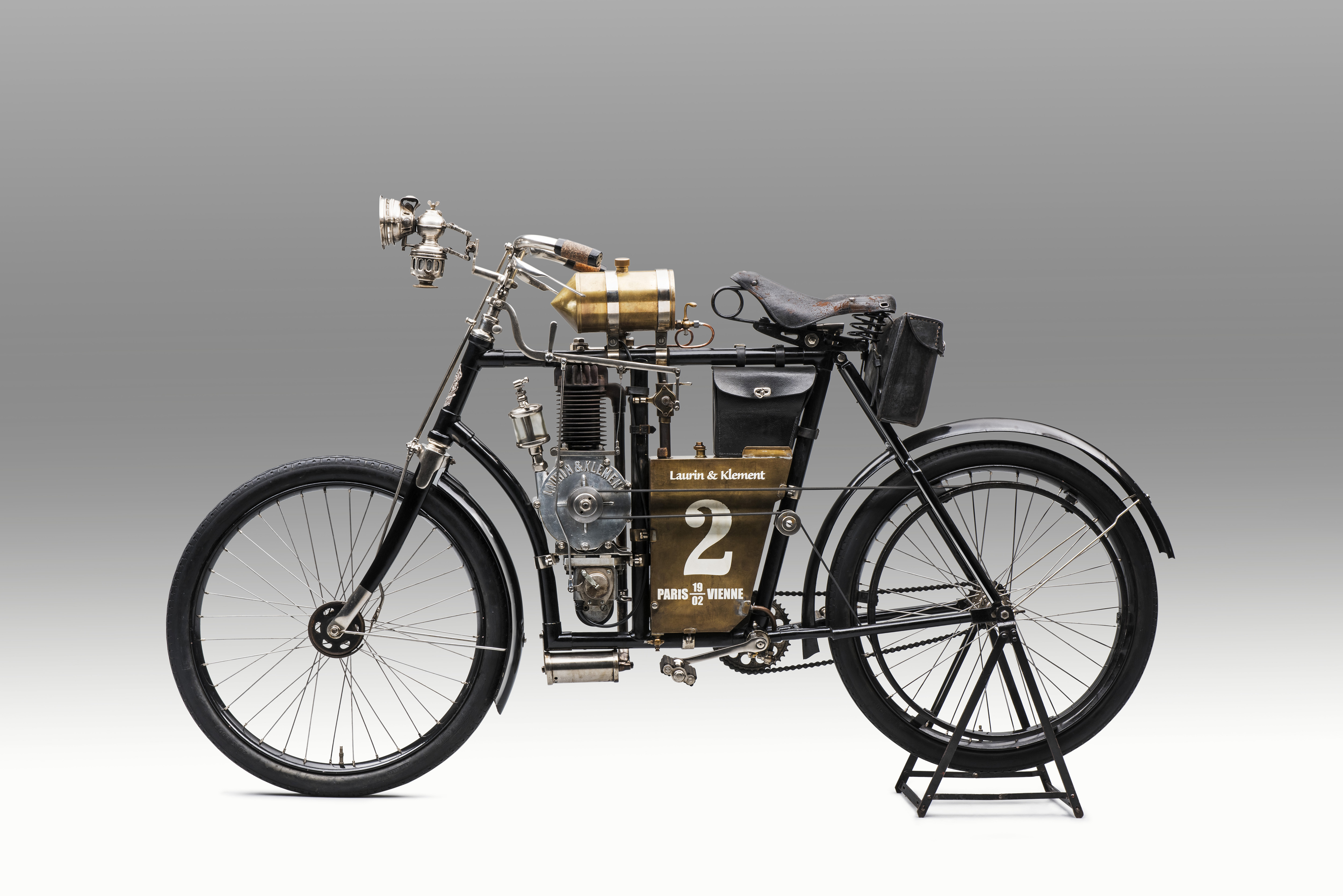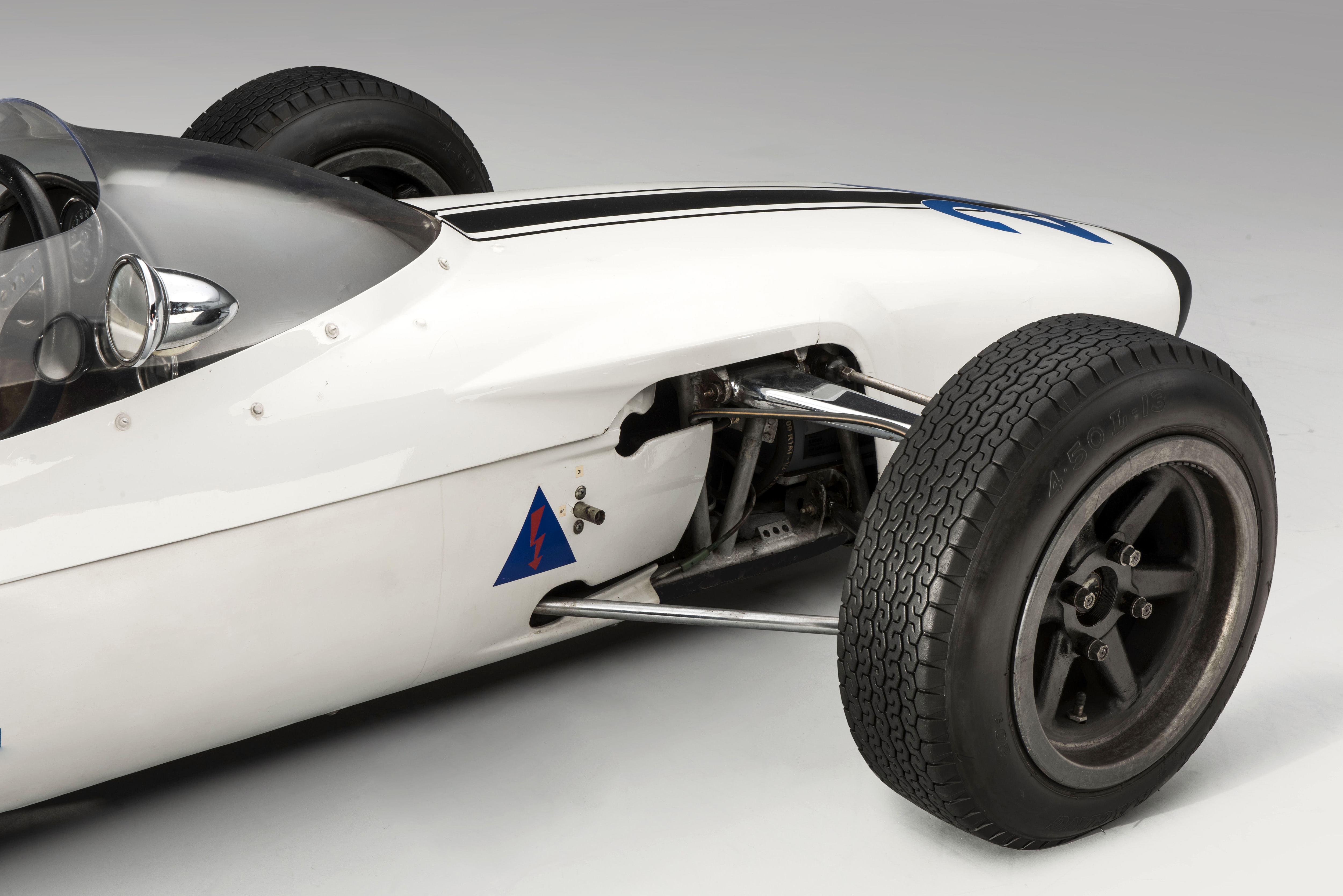› Since 1901, Mladá Boleslav based company has been well established in international racing
› The competition roots of the Czech brand reach back to the famous long-distance motorcycle races of the early 20th century
› Taking over the baton, ŠKODA cars for more than a century have been winning hill-climbs, races and rallies around the globe
› 2021 FIA Rally World Championship starts with a category victory for the ŠKODA FABIA Rally2 evo at the Rallye Monte-Carlo
› ŠKODA FABIA Rally2 evo continues the tradition set by such legendary cars like the ŠKODA POPULAR, the ŠKODA 130 RS and the ŠKODA FAVORIT 136 L
Mladá Boleslav, 25 February 2021 – ŠKODA Motorsport builds on a tradition spanning 120 years. In 1901, a L&K motorcycle built by the company’s founding fathers Václav Laurin and Václav Klement competed in a 1,200 kilometres race between the French capital Paris and Berlin in Germany. Switching from two to four wheels only four years later, L&K became a household name in car racing as well. Building on such highlights as class wins at the Rallye Monte-Carlo and the 24 hours race in Spa-Francorchamps (Belgium), ŠKODA celebrated more victories on race circuits and rally tracks during the 1970s and ’80s. Today, the ŠKODA FABIA Rally2 evo continues the success story of ŠKODA Motorsport by winning titles around the globe, from national championships to the FIA World Rally Championship.
Early years and first victories
The love of motor racing goes all the way back to the company’s founding fathers Václav Laurin and Václav Klement (L&K). After starting with a bicycle repair and manufacture company in Mladá Boleslav, then part of the Austro-Hungarian empire, they started producing motorcycles as early as 1899. Only two years later, L&K entered the Paris to Berlin race with the single-cylinder model TB. Factory rider Narcis Podsedníček arrived to the finish in the German capital as first motorbike – unfortunately after the official time-keeping enclosure. He was disqualified, albeit celebrated as moral winner.
Although Václav Klement was an avid motorcycle racer himself, he and business partner Václav Laurin saw their economic future on four wheels and eventually stopped to produce motorcycles. From 1905 onwards, L&K cars continued the company’s success story. A Laurin & Klement FCS set a speed record at Brooklands in England (1908). Powered by a four-cylinder engine delivering roughly 100 hp, the open car reached 118.72 kilometres per hour. From 1910 for five years in a row, the three cars strong L&K factory team won a gold medal at the notorious Alpine Run (Alpenfahrt). For the first time in 1912, a car sporting the L&K logo appeared on the entry list of the Rallye Monte-Carlo.
1936 – 1986: ŠKODA established as force to be reckoned in motor racing
In 1925, Pilsen based industrial company ŠKODA became a strategic partner of Laurin & Klement. Using the new possibilities, the now ŠKODA branded cars explored new technical frontiers, for example with a central tube frame, independent suspension and aerodynamically advanced bodywork. In January 1936, a ŠKODA POPULAR SPORT took second place in its category at the gruelling, nearly 4,000 kilometres long Rallye Monte-Carlo. The ŠKODA RAPID repeated this success one year later. In 1948, the ŠKODA 1101 production model celebrated a triple class victory at the 24 hours race in Spa-Francorchamps (Belgium). The ŠKODA SPORT, a two seater special based on ŠKODA 1101 model, took part in the famous 24 hour race in Le Mans in 1950. In 1953, a supercharged engine powered the ŠKODA SUPERSPORT to 197.8 kph, making it the fastest Czech car of its era. Both types of open sports cars based on the ŠKODA 1101 production model achieved many victories on circuit races in Eastern Europe. Later, the ŠKODA 1100 OHC special was more proof of the company’s brilliant engineers defying the restrictions of the so-called Iron Curtain. The open two-seater with fibreglass body work was nearly unbeatable.
Introduced in 1959, the ŠKODA OCTAVIA TS raced from one success to the next in the touring cars class with displacement under 1.3 litres. In 1961, not only did the Finnish team of Esko Keinänen and Rainer Eklund win its class at the Rallye Monte-Carlo, they also took a sensational sixth place in the overall ranking. Again in 1962 and 1963, crews in ŠKODA OCTAVIA TS won the class.
The ŠKODA 1000 MB opened the next chapter for the brand in the 1960s. The first ŠKODA with rear-wheel drive and rear-mounted engine again represented a new technological approach also in racing cars. With the successor ŠKODA 130 RS, especially Norwegian rally driver John Haugland achieved a lot of remarkable results. The car, because of its technical layout given the affectionate nickname “Porsche of the East”, won its class at the 1977 Rallye Monte-Carlo and the Acropolis Rally in 1978, 1979 and 1981. The 130 RS also won ŠKODA the manufacturer title of the European Touring Car Championship 1981. Its successor, ŠKODA 130 LR, was driven to class victories at the RAC Rally, British round of the World Rally Championship, in 1985 and 1986.
1990s: Further success in the World Rally Championship (WRC)
ŠKODA’s presence in modern motorsports started with the Rallye Monte-Carlo of 1991. Pavel Sibera/Petr Gross, driving a ŠKODA FAVORIT 136 L, won the class four years in a row (1991-1994). In 1994, ŠKODA also took the FIA World Rally Championship’s F2 Cup for vehicles featuring engines with less than two-litre capacity and one driven axle. In 1996, the new ŠKODA FELICIA Kit-Car won its class at the Rallye Monte-Carlo, again with the crew Sibera/Gross. With Swedish professional Stig Blomqvist at the wheel, the ŠKODA FELICIA Kit-Car also achieved a remarkable third place overall at the RAC Rally in the United Kingdom. In January 1997, Emil Triner/Julius Gál repeated the Rallye Monte-Carlo class win.
With the ŠKODA OCTAVIA WRC, introduced in 1999, the factory team entered the FIA World Rally Championship at top level for the first time. The 300 hp all-wheel-drive vehicle with turbo engine was the ŠKODA brand’s first so-called World Rally Car. 2001 was a remarkably successful year for ŠKODA Motorsport. German factory crew Armin Schwarz/Manfred Hiemer started the season by finishing the Rallye Monte-Carlo fourth overall. A couple of weeks later, the toughest long-distance rally in the championship, the Safari Rally in Kenya, saw the brand’s greatest success in WRC: Schwarz/Hiemer achieved an outstanding third place overall. The ŠKODA OCTAVIA WRC was also successful in many national championships. From 2003 to 2007, the successor model, the ŠKODA FABIA WRC, made the next a big impact for the Czech brand. In 2005, the legendary Colin McRae was on course to finishing second at the WRC round in Australia, when an unfortunate problem during service stopped him.
2000s: ŠKODA FABIA SUPER 2000 and ŠKODA FABIA R5 write motorsport history
In 2009, the ŠKODA FABIA SUPER 2000 took the rally scene by storm. In 2012 and 2013, the two‑litre engined all-wheel drive car won its class at the Rallye Monte-Carlo with crews Kevin Abbring/Lara Vanneste (NDL/BEL) and Sepp Wiegand/Frank Christian (GER/GER). More milestones for the ŠKODA FABIA SUPER 2000 were three title wins in a row in the FIA European Rally Championship: In 2012 with Juho Hänninen/Mikko Markkula (FIN/FIN), in 2013 with Jan Kopecký/Pavel Dresler (CZE/CZE) and in 2014 with Esapekka Lappi/Janne Ferm (FIN/FIN). On top of that, Juho Hänninen won the S-WRC category of the FIA World Rally Championship in 2011 and the Intercontinental Rally Championship (IRC) in 2010, while Andreas Mikkelsen and Ola Fløene (NOR/NOR) took the IRC title in 2011 and 2012. The FIA Asia-Pacific Rally Championship (APRC) was won by crews driving a ŠKODA FABIA SUPER 2000 three years in a row (2012-2014). In total, the ŠKODA FABIA SUPER 2000 won 50 national and international titles worldwide, thereby writing the most successful chapter in ŠKODA’s motorsport history – until its successor, the ŠKODA FABIA R5, surpassed it.
The ŠKODA FABIA R5, powered by a 1.6 litres turbo engine, was an instant hit. ŠKODA Motorsport factory drivers won the FIA World Rally Championship’s WRC2/WRC2 Pro category in 2016 (Esapekka Lappi/FIN), 2017 (Pontus Tidemand/SWE), 2018 (Jan Kopecký/CZE) and again in 2019 with the updated ŠKODA FABIA R5 evo (Kalle Rovanperä/FIN). Driving the ŠKODA FABIA R5 evo, French privateers Pierre-Louis Loubet/Vincent Landais were crowned WRC2 Champions in 2019. ŠKODA also took the WRC2/WRC2 Pro manufacturers’ title five years in a row from 2015 to 2019. During the same era, ŠKODA celebrated multiple titles in the FIA European Rally Championship (ERC), the FIA Asia-Pacific Rally Championship (APRC), the FIA South American Rally Championship (CODASUR), FIA African Rally Championship (ARC). Numerous national championships were won by teams competing in a ŠKODA FABIA R5 or ŠKODA FABIA R5 evo.
2020: The ŠKODA FABIA Rally2 evo continues the success story
In 2020, the ŠKODA FABIA R5 evo was re-named to ŠKODA FABIA Rally2 evo to comply with the new FIA class system. At the same time, ŠKODA Motorsport changed its FIA World Rally Championship strategy from fielding an own factory team to supporting private teams and crews running ŠKODA FABIA Rally2 evo. One of these, Toksport WRT, became WRC2 Team Champion 2020. Among the 14 titles and trophies, ŠKODA Motorsport customers won in 2020, one is a historical landmark for the Czech brand: Barry McKenna and James Fulton from Ireland won the ARA National Championship Trophy in the USA, the first ever such title for the ŠKODA FABIA Rally2 evo.
The 2021 WRC season started with another victory for the ŠKODA FABIA Rally2 evo. Andreas Mikkelsen/Ola Fløene (NOR/NOR) drove the updated 2021 generation of the car, run by ŠKODA Motorsport supported team Toksport WRT, to first in WRC2 category at the Rallye Monte-Carlo.
Five milestones of ŠKODA’s racing history
L&K “Motocyclette” TB (1901)
Inspired by the motorcycles of the Werner brothers from France, Václav Laurin invented a new motorcycle-design principle by building the frame around the engine and positioning all control elements on the handle bars. The “motocyclette” model TB was powered by single-cylinder engine. With Laurin’s business partner Václav Klement being an avid motorcycle racer himself, L&K soon turned to motorsports as marketing tool.
On 27 June 1901, factory racer Narcis Podsedníček took off from the French capital Paris in a 1,200 kilometres race to Berlin in Germany. Being one of ten competitors in the motorcycles and three-wheelers category, Podsedníček was the only rider to finish the last of three legs. When his L&K roared through the streets of Berlin in the early hours of 30 June, the time keepers were already off duty. Instead, a policeman testified his arrival time. But as race control followed the rules to the last letter, Podsedníček was disqualified, albeit celebrated as moral winner.
The following years, L&K motorcycles were among the most successful in international races. In 1905, the L&K factory rider Václav Vondřich won the renowned “Coupe International” in Dourdan (France), the unofficial motorcycle world championship. Nevertheless, L&K ceased motorcycle production in 1908, from there on concentrating on cars.
L&K FC (1908)
The first L&K automobile rolled out of the Mladá Boleslav production hall in 1905. Again, Laurin and Klement took to racing to promote their new products. Driving force was Otto Hieronymus, a German born engineer and race driver hired by L&K as head of development. While L&K became one of the biggest manufactures of so-called „voiturettes“ (small cars), Hieronymus also had powerful racing cars in mind. His model FC had a four-cylinder engine with a capacity of 2.4 litres, good for a speed of up to 90 kph.
One of the first to race the car was Count Alexander ”Sascha” Kolowrat, a gentleman driver with Bohemian roots. Kolowrat, who was also known as “Count Kilowatt” for his energetic personality, had already won races on L&K motorcycles, when he turned to cars. Hieronymus and Kolowrat formed a successful team, winning amongst others the legendary hill-climb events at Semmering near Vienna (Austria) and Gaillon (Switzerland) at the wheel of a L&K FC.
Again driving an FC model, Kolowrat won the class of the Zbraslav-Jíloviště hill-climb in 1908. The following year he went up against 102 rivals in the German Prince-Heinrich Rally. While Hieronymus took a L&K FC to class victory at the 700 kilometres race from St. Petersburg to Moscow in 1908, Kolowrat was instrumental in the L&K team’s success in the challenging St. Petersburg-Sevastopol race and also won the Carpathian Trophy (1911). When Kolowrat, at that time a board member of L&K, stood at the start of the second edition of the Rallye Monte‑Carlo in 1912, it marked the brand’s first participation at today’s most famous rally.
ŠKODA POPULAR (1936)
In the 1930s, the company – now under the name of ŠKODA – made a return to motorsports. The ŠKODA POPULAR was the first ŠKODA car with a modern central tube frame and independent suspension. It also gave a powerful boost to the competitions department. Zdeněk Pohl and co-driver Jaroslav Hausman attracted much attention, when they entered the 1936 Rallye Monte‑Carlo with a ŠKODA POPULAR SPORT, a two-seater convertible version of the model.
The crew mastered the 3,852 kilometres route from Athens to Monaco in four days without collecting any penalty points. Even when Pohl and Hausman had a heater, thermos bottles and a heated windscreen as extras in their car, the winterly tour over mostly unpaved roads in Greece, Yugoslavia, Hungary, Austria, Germany and France was an exhausting adventure. Pohl/Hausman drove the ŠKODA POPULAR SPORT to second in class, spurring further enthusiasm for rally racing in its Czechoslovakian homeland. Encouraged by this success, ŠKODA also presented the particularly sporty ŠKODA POPULAR MONTE CARLO special series.
ŠKODA F3 (1965)
Single-seater race series serve as feeders to Formula 1 since its creation in 1950. Still today, Formula 3 presents one of the first steps up the ladder, already in the beginning of the 1960’s contesing in countless countries. Even behind the so-called Iron Curtain championships were organised.
When in 1964 the engine regulations changed to a one-litre capacity limit, ŠKODA developed its own F3 racer. The engine was the four-cylinder of the 1000 MB, mounted in the rear and delivering up to 90 hp. The slim body made from alloy kept the weight down at 410 kilograms. The open‑wheeler with the project number 992 reached a top speed of 210 kph. In 1968, Czech ŠKODA factory driver Miroslav Fousek won the Eastern European Formula 3 Championship. Another design was used for the Lucia F3 car, built inside the subsidiary plant in Vrchlabí in 1966. The car with the same power unit was used during the 1966-1969 seasons in the Czechoslovak national championship.
ŠKODA FAVORIT 136 L (1994)
With ŠKODA’s entry into the Volkswagen Group in 1991, motorsport activities were further extended. Already in 1989, the motorsport department developed a rally version of the FAVORIT 136 L. Sporting front engine and front-wheel drive, the Bertone-designed model represented a change of strategy for ŠKODA. The engine was the trusted 1.3 litres four-cylinder, delivering more than 110 hp in rally disguise.
From 1990, ŠKODA Motorsport sent a factory team of two cars to selected rounds of the FIA World Rally Championship (WRC). The reliable FAVORIT shone especially on rough gravel rallies. Pavel Sibera and co-driver Petr Gross won the class on the Acropolis Rally in Greece and the Finnish 1000 Lakes Rally, backed-up by another class win by Ladislav Křeček/Bořivoj Motl at the Sanremo Rally in Italy. More class victories followed, highlighted by Sibera/Gross winning the category four years in a row at the Rallye Monte-Carlo. In 1994 ŠKODA became manufacturer champion of the so-called F2 World Cup reserved for cars with normally aspirated engines up to two litres and one driven axle. That year, Sibera/Gross and teammates Emil Triner/Jiří Klíma won the class on three out of ten WRC rounds.
For circuit racing series with more liberal regulations, ŠKODA Motorsport developed an even more high-tech version of the FAVORIT. With the capacity enlarged to 1.5 litres, the engine delivered 145 hp and was matched to a six-speed gearbox. The body work was fabricated mostly from fibre class, making this car especially light.
Zbyněk Straškraba
Communications Motorsport
T +420 605 293 168
zbynek.straskraba@skoda-auto.cz





































